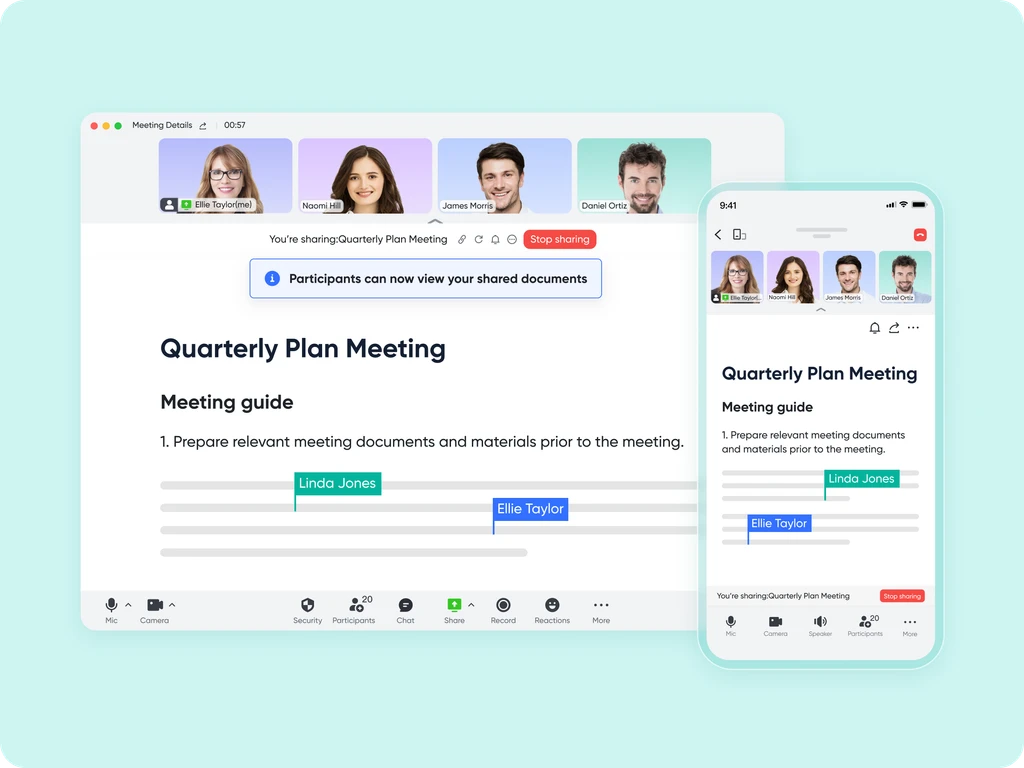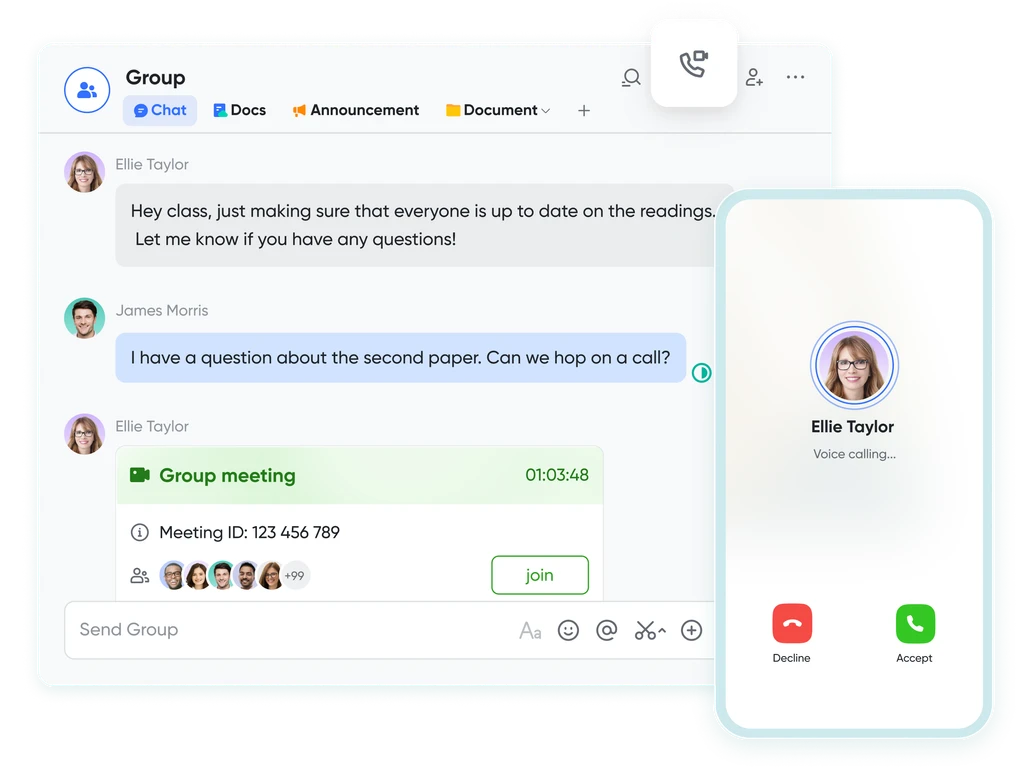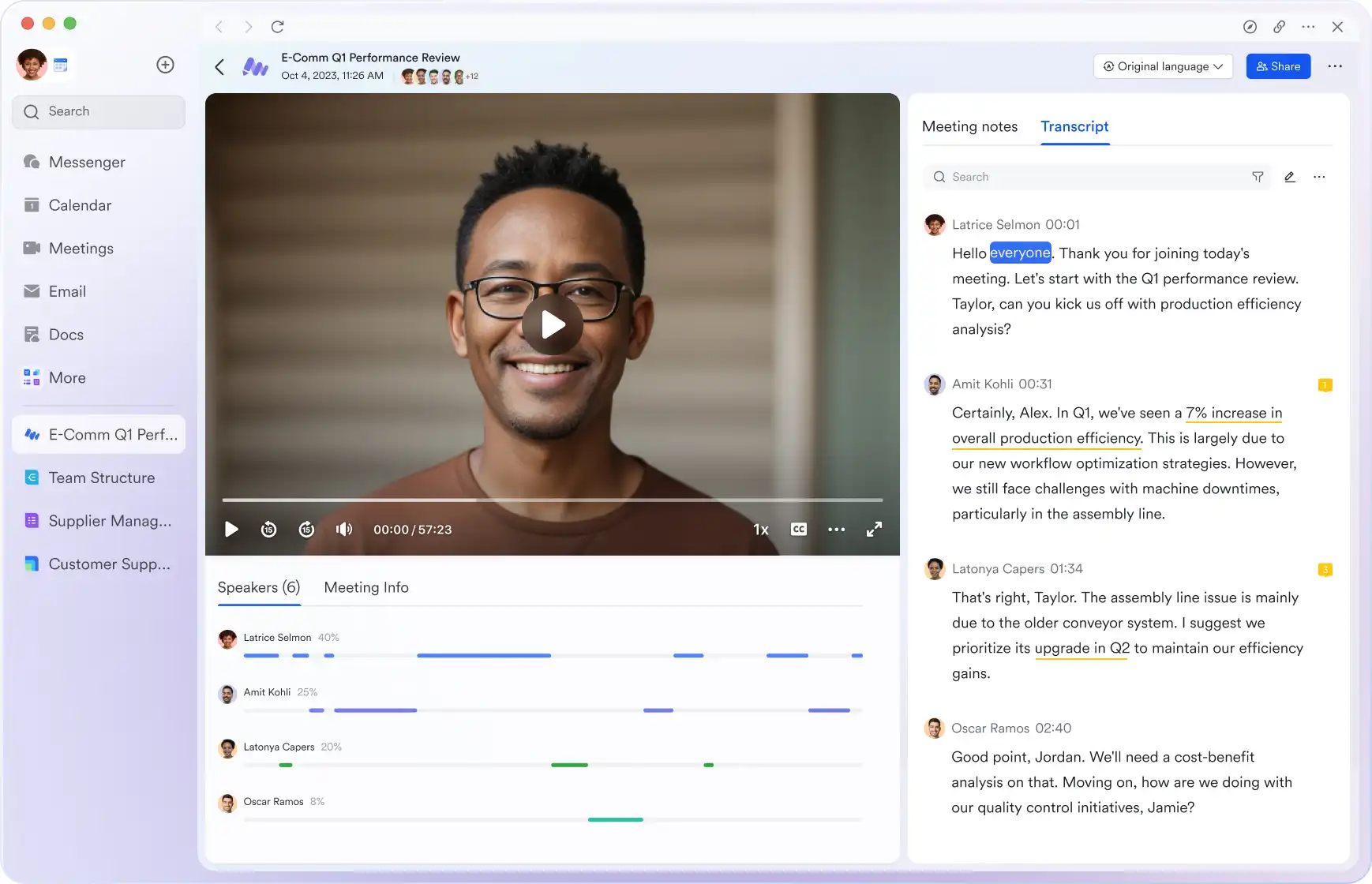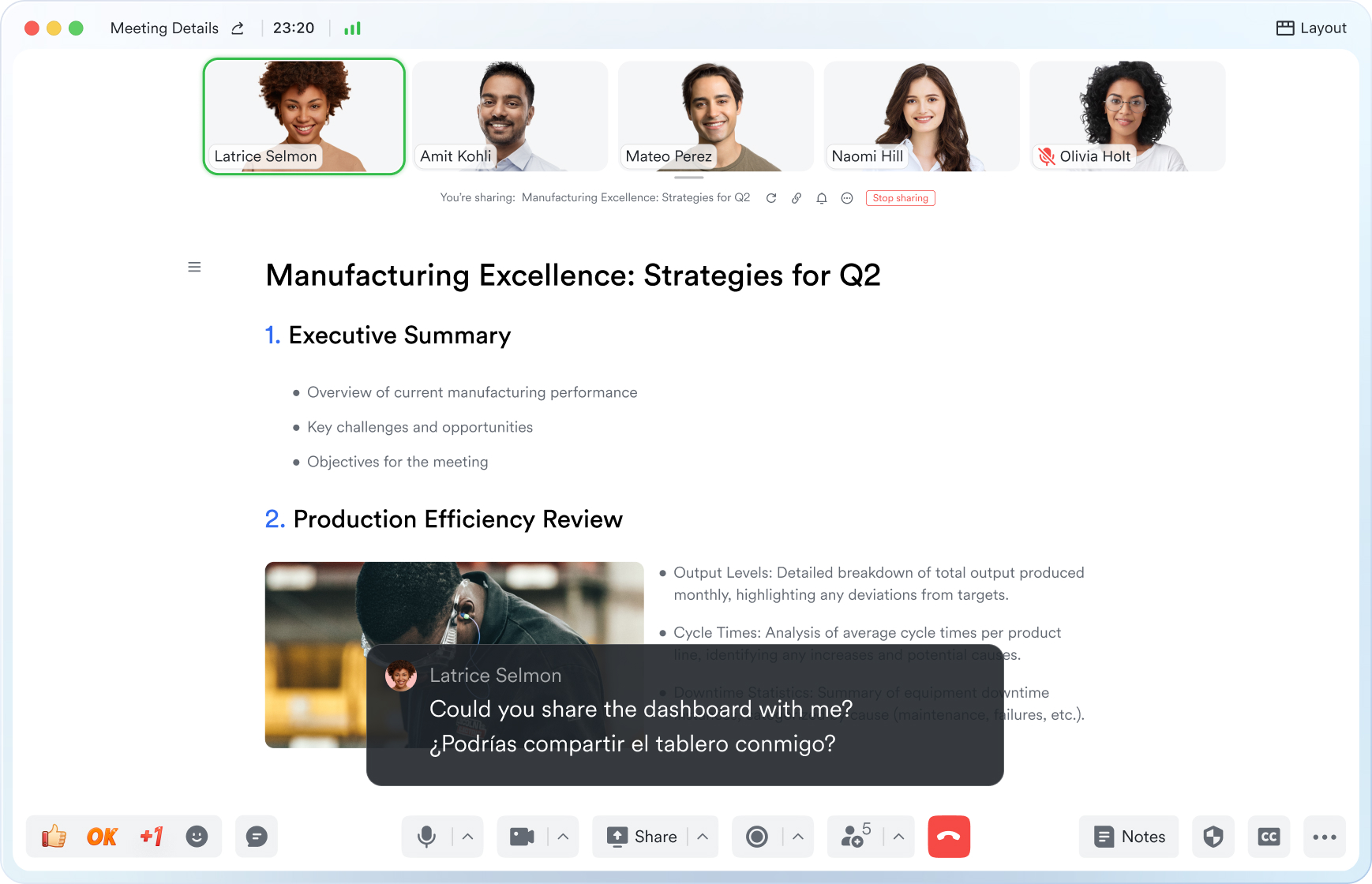Cross Functional Team Meeting
This guide will walk you through the essential elements of use cross functional team meeting to keep your attendees aligned and engaged.
Try Lark for Free
In the rapidly evolving landscape of modern business, cross-functional team meetings have emerged as pivotal forums for fostering collaboration, driving innovation, and achieving strategic alignment within organizations. By bringing together diverse expertise and perspectives, these meetings play a crucial role in breaking down silos, promoting cohesive decision-making, and propelling collective success. As we venture into the promising realm of 2024 and beyond, it becomes increasingly essential for organizations to optimize their approach to cross-functional team meetings, leveraging innovative strategies and best practices to maximize their impact.
Use Lark Meetings to turn meetings into true collaborative experiences.
What is a cross-functional team meeting?
A cross-functional team meeting serves as a gathering that brings together individuals from different departments or functional areas within an organization. This collaborative platform facilitates the exchange of ideas, insights, and expertise across diverse disciplines, aiming to address complex challenges, drive strategic initiatives, and foster a holistic understanding of organizational goals. Hallmarked by its inclusive nature, these meetings strive to harness the collective intelligence of multidisciplinary teams, leveraging varied perspectives to drive informed decision-making and generate innovative solutions.
Goals of cross-functional team meeting
The overarching goals of a cross-functional team meeting encompass the cultivation of a cohesive organizational culture, seamless alignment of strategic objectives, and the promotion of collaborative problem-solving. By nurturing a shared understanding of key initiatives and fostering open communication pathways, these meetings seek to drive collective ownership of organizational goals while encouraging a culture of inclusivity, respect, and mutual empowerment among team members of diverse backgrounds.
Who should attend cross-functional team meeting?
In the context of cross-functional team meetings, the participation of individuals representing diverse functional areas is crucial. This includes departmental heads, project managers, subject matter experts, and key stakeholders whose inputs and perspectives are integral to the topics being discussed. By ensuring the representation of relevant stakeholders, these meetings create opportunities for comprehensive discussions, informed decision-making, and holistic problem-solving, thus enhancing the overall efficacy of the collaborative process.
Related:
Unlock the Power of Webinars: A Comprehensive Guide to Boost Your Business | Lark Blog | Lark BlogLearn more about Lark x Meetings
Topics, agenda, and structure of cross-functional team meeting
The efficacy of a cross-functional team meeting hinges on the thoughtful curation of topics and the structured organization of the agenda. The selection of topics should be driven by relevance, urgency, and alignment with the broader organizational objectives, ensuring that the discussions are focused on pivotal issues that necessitate cross-functional insights and collaboration. Furthermore, the agenda should be strategically structured to allocate sufficient time for each topic, incorporate interactive elements, and allow for diverse perspectives to be articulated.
Learn more about Lark x Meetings
How often does a cross-functional team meeting occur?
The frequency of cross-functional team meetings is contingent upon the nature of the organization, the scope of ongoing projects, and the need for cross-functional coordination. While some organizations may conduct these meetings on a weekly or bi-weekly basis, others may opt for a monthly cadence, aligning the meeting frequency with the urgency and dynamics of the collaborative initiatives being pursued.
Key differences between cross-functional team meeting and another similar meeting
A distinct feature of cross-functional team meetings is the diverse composition of participants from different functional areas within the organization. This sets them apart from departmental meetings or intra-team gatherings where the focus is more centralized around functions or specific projects. Unlike single-discipline meetings, cross-functional meetings emphasize holistic problem-solving and a comprehensive understanding of interlinked organizational challenges.
Learn more about Lark x Meetings
Three practical examples of cross-functional team meetings
Example 1: product development alignment
Example 1: product development alignment
In a leading tech corporation, a cross-functional team meeting was convened to align product development strategies with marketing initiatives. Through collaborative discussions, the team achieved streamlined coordination, resulting in the successful launch of a new product line.
Example 2: project integration summit
Example 2: project integration summit
A multinational construction firm conducted a cross-functional team meeting to synchronize the efforts of engineering, procurement, and finance teams for a large-scale project. This collaborative initiative facilitated proactive issue resolution and resource optimization, elevating project efficiency.
Example 3: organizational restructuring dialogue
Example 3: organizational restructuring dialogue
In response to organizational changes, a cross-functional team meeting brought together leaders from various departments to strategize and align their approaches. This collective effort fostered clarity, minimized disruption, and laid a robust foundation for the restructuring process.
Common pitfalls of cross-functional team meetings
Despite their immense potential, cross-functional team meetings may encounter several challenges, including decision-making bottlenecks, communication barriers, and the potential for conflicting priorities among participants. Additionally, inadequate preparation, lack of clear facilitation, and the absence of structured follow-up mechanisms can impede the effectiveness of these collaborative gatherings.
Related:
Unlock the Power of Webinars: A Comprehensive Guide to Boost Your Business | Lark Blog | Lark BlogLearn more about Lark x Meetings
Dos and don’ts of cross-functional team meetings
| Dos | Don'ts |
|---|---|
| Encourage active participation from all | Avoid dominating discussions |
| stakeholders, fostering a culture of openness | Neglect to facilitate equitable participation |
| and inclusivity. | from all team members. |
| Establish clear objectives and an agenda | Conduct meetings without clear agendas and |
| that aligns with organizational goals. | predefined outcomes. |
| Enable collaborative decision-making and | Disregard diverse perspectives and insights, |
| innovation through cross-functional inputs. | leading to narrow-focused discussions. |
What makes a virtual cross-functional team meeting successful?
In the context of virtual interactions, successful cross-functional team meetings are characterized by seamless technological integration, clear communication channels, and dynamic participation. Leveraging advanced virtual collaboration platforms, such meetings can drive global synchronization, transcend geographical barriers, and foster high-impact cross-functional engagements, paving the way for sustained collaborative success.
Related:
Master the Art of Meeting Notes with Lark for Enhanced Collaboration | Lark Blog | Lark BlogLearn more about Lark x Meetings
Typical takeaways of the cross-functional team meeting
Participants in cross-functional team meetings often derive valuable takeaways, including enhanced cross-functional understanding, clarified strategic direction, a sense of unified purpose, and the identification of actionable insights for driving projects and initiatives forward.
Questions to ask in the cross-functional team meeting
Amidst the multi-faceted discussions within a cross-functional team meeting, several questions stand as pivotal for eliciting valuable insights and driving effective collaboration:
- How can the cross-functional team align its strategies with the overarching organizational objectives?
- What are the key hurdles and opportunities observed from a multidisciplinary perspective?
- How can cross-functional barriers be addressed, and siloed mindsets be mitigated for cohesive decision-making?
- What role can cross-functional collaboration play in driving innovation and enterprise-wide strategic initiatives?
- How will the outcomes of this meeting be translated into actionable steps and integrated into day-to-day operations across functional domains?
Related:
Unlock the Power of Webinars: A Comprehensive Guide to Boost Your Business | Lark Blog | Lark BlogLearn more about Lark x Meetings
Conclusion
In the trajectory of contemporary organizational dynamics, the strategic orchestration of cross-functional team meetings holds immense importance as a catalyst for unified decision-making and instrumental collaboration. By embracing the best practices, leveraging innovative modalities, and aligning with the transformative spirit of 2024, organizations can harness the full potential of cross-functional collaboration, steering towards a future defined by synergy and shared success.
Use Lark Meetings to turn meetings into true collaborative experiences.
A Game Changer for Cross Functional Team Meeting: Empower your team with Lark Meetings
In the fast-paced and dynamic world of modern business, effective communication and collaboration are crucial for success of Cross Functional Team Meeting. Here we introduce Lark Meetings to serve as a centralized hub for all communication needs.
Transform your meetings into collaborative endeavors

Leverage the potency of in-call document sharing, intelligent meeting minutes, and mobile-optimized features to enhance productivity collaboratively, irrespective of your location or schedule.
Seamlessly collaborate in real-time, across any device

Share live documents instead of just screen views. Participants can navigate and edit simultaneously within the video call window, even while on the move.
Shift your focus to engagement, not note-taking

Lark Minutes automatically converts video meetings into transcripts, facilitating easy viewing, searching, and collaborative editing. Stay in the loop asynchronously, even if you can't attend the live meeting. Lark Minutes for meeting minutes support translation into 10+ different languages.
Break language barriers in communication

Lark Meetings provide real-time translation for subtitles, allowing individuals from diverse backgrounds to express themselves in their native languages. Ensure every voice is heard, regardless of geographical location. Live subtitles currently support translations from English, Chinese, and Japanese to 10+ different languages. See more translation feature in Lark.
Connect with larger audiences
Host dynamic online meetings and events accommodating up to 1,000 participants, with the flexibility of up to 50 breakout sessions for intimate group discussions within the larger meeting context. Try more Lark features for free.








